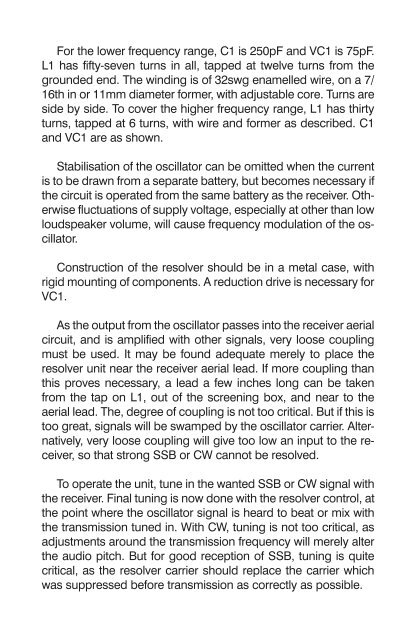50 (FET) Field Effect Transistor Projects - Battery Portable
50 (FET) Field Effect Transistor Projects - Battery Portable
50 (FET) Field Effect Transistor Projects - Battery Portable
- No tags were found...
Create successful ePaper yourself
Turn your PDF publications into a flip-book with our unique Google optimized e-Paper software.
For the lower frequency range, C1 is 2<strong>50</strong>pF and VC1 is 75pF.L1 has fifty-seven turns in all, tapped at twelve turns from thegrounded end. The winding is of 32swg enamelled wire, on a 7/16th in or 11mm diameter former, with adjustable core. Turns areside by side. To cover the higher frequency range, L1 has thirtyturns, tapped at 6 turns, with wire and former as described. C1and VC1 are as shown.Stabilisation of the oscillator can be omitted when the currentis to be drawn from a separate battery, but becomes necessary ifthe circuit is operated from the same battery as the receiver. Otherwisefluctuations of supply voltage, especially at other than lowloudspeaker volume, will cause frequency modulation of the oscillator.Construction of the resolver should be in a metal case, withrigid mounting of components. A reduction drive is necessary forVC1.As the output from the oscillator passes into the receiver aerialcircuit, and is amplified with other signals, very loose couplingmust be used. It may be found adequate merely to place theresolver unit near the receiver aerial lead. If more coupling thanthis proves necessary, a lead a few inches long can be takenfrom the tap on L1, out of the screening box, and near to theaerial lead. The, degree of coupling is not too critical. But if this istoo great, signals will be swamped by the oscillator carrier. Alternatively,very loose coupling will give too low an input to the receiver,so that strong SSB or CW cannot be resolved.To operate the unit, tune in the wanted SSB or CW signal withthe receiver. Final tuning is now done with the resolver control, atthe point where the oscillator signal is heard to beat or mix withthe transmission tuned in. With CW, tuning is not too critical, asadjustments around the transmission frequency will merely alterthe audio pitch. But for good reception of SSB, tuning is quitecritical, as the resolver carrier should replace the carrier whichwas suppressed before transmission as correctly as possible.

















